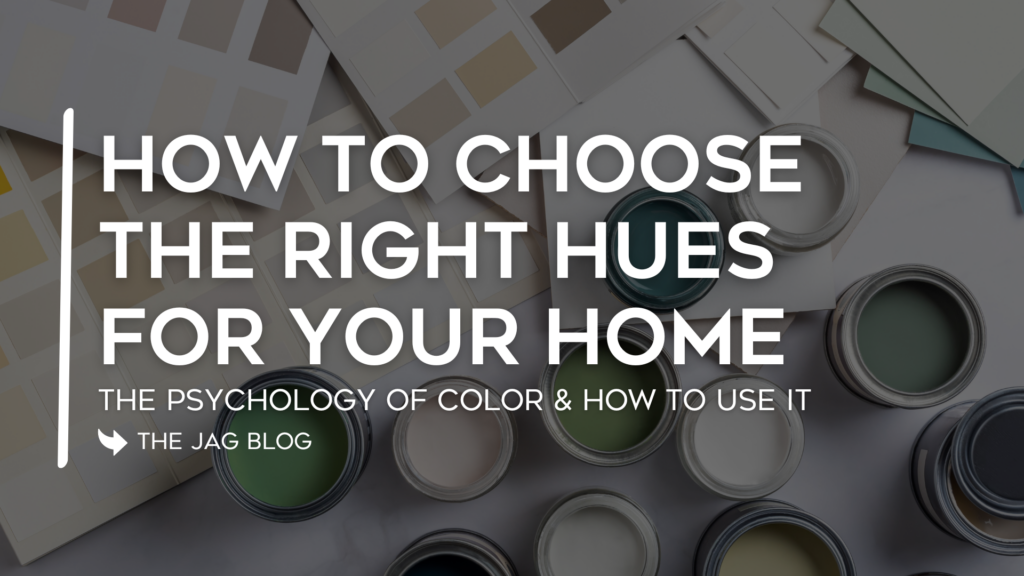The psychology of color: How to choose the right hues for your home

The use of color within a home can have a profound influence on your space. Colors can inspire emotion, set the tone for a room, and even stimulate your senses and set your mood. Color psychology, often used to examine how colors influence our emotions and behaviors, not only explains how colors can describe emotions. It can also be used to help designers choose what’s appropriate for a home to create a space that’s comfortable, unique, and inviting.
You may have heard how colors have specific meaning. For example, red represents passion and love while blue is peaceful. Those colors often translate into the home as well: a blue bedroom is calming while a yellow bedroom would overstimulate the senses and could potentially keep you overly stimulated and unable to rest. Sally Medicke, designer and owner of Raleigh’s Tres Belle Designs, says understanding the color chart and color psychology can go a long way toward helping a person find the right color options for the home. She recommended the following tips to create a home that fits your style and sets the right mood.
Start with a clean palette
Medicke said a great way to experiment with color is to start with something basic and layer in the color. “I try to get a neutral base — even for the colorful people,” she said. “Have a natural base, and then have select arts and select accessories.”
She often suggests painting the walls white, or a creamier alabaster color, which can be calming and represents freshness. From there, she said it’s smart to add in neutral furniture, then find ways to incorporate color that sets a mood. “Usually everybody likes that,” she said. “Even the people that like color.”
Use your home style as inspiration
Whites and natural greens are popular in 2024 because of a trend toward minimalism. However, Medicke said that may not work for all home styles. For example, in a modern, spacious home, she recommends muted, creamier colors that convey peacefulness. “I try to add swivel chairs, teddy bear fabrics, light creams with browns and lighter tans. It all goes with minimalism,” she explained.
Meanwhile, an older bungalow may be designed with bolder colors and more ornate furniture to match the style of the home. “Not everybody wants that minimalistic look. There are a lot of people that are just saying, ‘I don’t want to do modern. I’m going to go back to more of a traditional look,” she said.
Test color creatively
One trend Medicke said will be popular in 2024 is using accent walls to incorporate specific colors into a home. “One thing that’s really big right now are colored accent walls and wallpaper,” she said. I’ll add wallpaper to certain rooms—maybe even a master bedroom, back wall, laundry room, or powder room. I’d do something completely wild with lots of color.”
She suggested using lighter, more neutral paint colors to create an open flow, and then searching for the right colors for an inspired space. “You can bring out balance with art, pillows, accessories, even rugs, maybe some chairs.”
Consider today’s trends
Medicke said neutrals and moody colors remain the top trends for 2024 due in large part to the influence of minimalism. Sage green, deep blues, and browns are highly popular. But she believes those trends don’t always work in every home.
For example, Medicke said she recently staged a small three-bedroom home that wasn’t selling. “I did it in all neutrals. We did all white neutral chairs, and a neutral rug,” she said. “And then we popped orange and navies, and some lighter blues. Then we did art that was abstract, with oranges, salmons, and blues, and lots of mixed pillows. It looks so darn cute, but it feels so comforting.”


When in doubt, consult the color wheel
The color wheel is a great place to develop the right look for your home, Medicke said. “If you pull that wheel out, you do see how different sides are calming. Opposites create a lot of emotion, and when you pop things opposite sides of the color wheel, it creates more excitement,” she said. “Really think about what you’re looking for. And then just add different colors or look on the color wheel and see what is going to create the new thing you want.”
She suggested using the world around you for inspiration: “Think of colors opposite in nature. There are a lot of things that produce a ‘wow’ effect. Watermelon’s pink and green are opposite on the color palette. The ocean and the sand are calming, so you have tan and light blue. You’ve got to think about the mood that you want, then look at the color wheel and use it to pick out different colors.”
Choosing what’s right for your home
The final tip Medicke suggested is the most straightforward one: “You’ve got to be true to your style.”
The Jim Allen Group provides access to information on this blog/website as a public service for educational purposes only. Although reasonable efforts have been made to ensure that all of the information made available is current, accurate, and complete…[read more]


